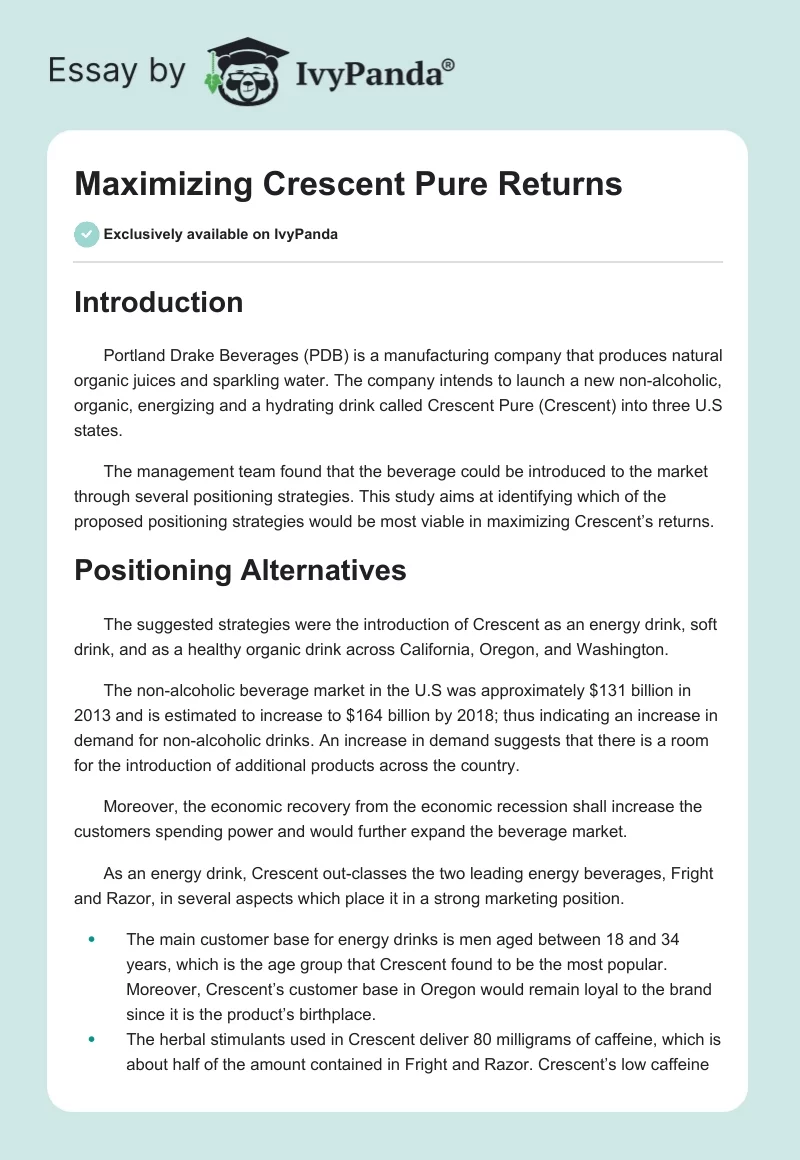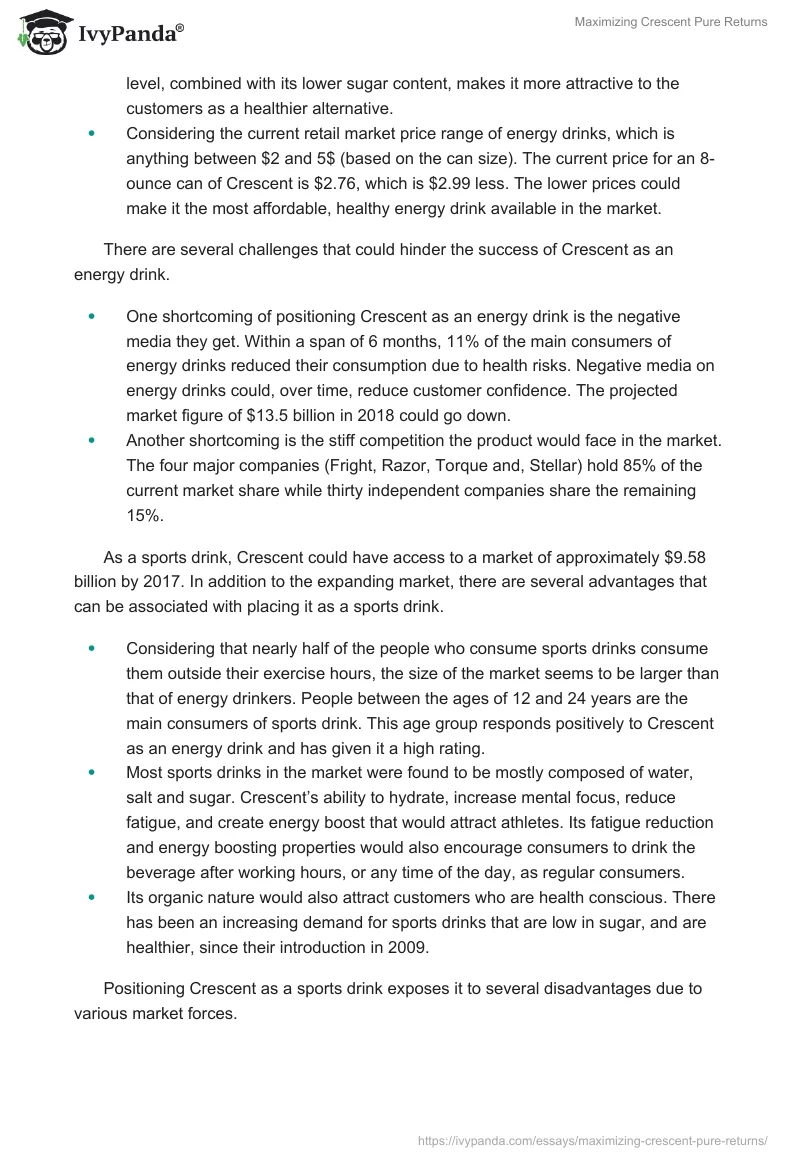Introduction
Portland Drake Beverages (PDB) is a manufacturing company that produces natural organic juices and sparkling water. The company intends to launch a new non-alcoholic, organic, energizing and a hydrating drink called Crescent Pure (Crescent) into three U.S states.
The management team found that the beverage could be introduced to the market through several positioning strategies. This study aims at identifying which of the proposed positioning strategies would be most viable in maximizing Crescent’s returns.
Positioning Alternatives
The suggested strategies were the introduction of Crescent as an energy drink, soft drink, and as a healthy organic drink across California, Oregon, and Washington.
The non-alcoholic beverage market in the U.S was approximately $131 billion in 2013 and is estimated to increase to $164 billion by 2018; thus indicating an increase in demand for non-alcoholic drinks. An increase in demand suggests that there is a room for the introduction of additional products across the country.
Moreover, the economic recovery from the economic recession shall increase the customers spending power and would further expand the beverage market.
As an energy drink, Crescent out-classes the two leading energy beverages, Fright and Razor, in several aspects which place it in a strong marketing position.
- The main customer base for energy drinks is men aged between 18 and 34 years, which is the age group that Crescent found to be the most popular. Moreover, Crescent’s customer base in Oregon would remain loyal to the brand since it is the product’s birthplace.
- The herbal stimulants used in Crescent deliver 80 milligrams of caffeine, which is about half of the amount contained in Fright and Razor. Crescent’s low caffeine level, combined with its lower sugar content, makes it more attractive to the customers as a healthier alternative.
- Considering the current retail market price range of energy drinks, which is anything between $2 and 5$ (based on the can size). The current price for an 8-ounce can of Crescent is $2.76, which is $2.99 less. The lower prices could make it the most affordable, healthy energy drink available in the market.
There are several challenges that could hinder the success of Crescent as an energy drink.
- One shortcoming of positioning Crescent as an energy drink is the negative media they get. Within a span of 6 months, 11% of the main consumers of energy drinks reduced their consumption due to health risks. Negative media on energy drinks could, over time, reduce customer confidence. The projected market figure of $13.5 billion in 2018 could go down.
- Another shortcoming is the stiff competition the product would face in the market. The four major companies (Fright, Razor, Torque and, Stellar) hold 85% of the current market share while thirty independent companies share the remaining 15%.
As a sports drink, Crescent could have access to a market of approximately $9.58 billion by 2017. In addition to the expanding market, there are several advantages that can be associated with placing it as a sports drink.
- Considering that nearly half of the people who consume sports drinks consume them outside their exercise hours, the size of the market seems to be larger than that of energy drinkers. People between the ages of 12 and 24 years are the main consumers of sports drink. This age group responds positively to Crescent as an energy drink and has given it a high rating.
- Most sports drinks in the market were found to be mostly composed of water, salt and sugar. Crescent’s ability to hydrate, increase mental focus, reduce fatigue, and create energy boost that would attract athletes. Its fatigue reduction and energy boosting properties would also encourage consumers to drink the beverage after working hours, or any time of the day, as regular consumers.
- Its organic nature would also attract customers who are health conscious. There has been an increasing demand for sports drinks that are low in sugar, and are healthier, since their introduction in 2009.
Positioning Crescent as a sports drink exposes it to several disadvantages due to various market forces.
- The main shortcoming of positioning crescent as a sports drink would be its pricing. The current market price stands between 2 and 3 dollars per 12 to18 ounces sized cans, while Crescent goes for $2.75 per 8 ounces can.
- Although the sports drink market experiences lower competition than the energy drink market, there is a lower market share per company, since the two main competitors, Gleam and Drip share 73% and 21% if the total market.
The natural organic nature of Crescent allows it to enter the healthy non-alcoholic market.
- The guarana seed used in making Crescent makes the beverage deliver the same energizing effect as a cup of coffee. Its caffeine content allows it to compete with beverages such as coffee’s substitute and even attract the younger demographic as a breakfast beverage.
- The sugar content in Crescent comes from processed raw sugar cane; thus, making it entirely natural. These aspects of the drink allow it to compete with similar beverages in the market as a healthy non-alcoholic drink. In addition, the beverage does not have the crash effect that other similar high fructose drinks cause.
- The nutritional information indicated on each can of Crescent accompanied by the label that states that the ingredients are organic, increases confidence of healthy customers. Moreover, ginseng, which is one of the herbs used in making the beverage, increases mental focus and reduces fatigue.
- On the downside, Crescent was found to be less sweet than most of the beverages available in the market. Its low sugar content would place it at a disadvantage with the younger demographic in the market, since they prefer sweet beverages.
Marketing Mix
The product’s name is Crescent, and it’s a low-sugar, organic, clear colored liquid packed in a tall silver 8-ounce can. The management team set price at $2.75 per 8-ounce can for retailers and $29.76 per case when sold to distributors. The launch of the product is limited to California, Oregon, and Washington.
In addition, the marketing strategy has been set at $750,000.
These decisions have placed a constraint as to which positioning strategy can be chosen. The organic nature of the product means that the positioning strategy chosen must target natural foods markets. The pricing of the product does not allow room for any adjustment.
The inflexibility of the set price and packaging may end up being either higher or lower than the market price. The launch is limited to three states and could create a bias towards the position taken. The bias may come out as a result of customer preferences rather than marketing advantage.
Break-even Analysis
For PDB to break-even the returns it makes from selling, crescent must be able to cover the costs incurred in both production and advertising. The production cost for each can of crescent stands at $1.02 and the selling price per can is $1.24. Each case holds 24 cans, and the cost per case of crescent is $24.48 and the price at $29.76.
The expected profit per case sold is $5.28. Since the cost of production is covered, the profits will have to cater for the 750,000 advertisement cost. It would take 142,046 cases of Crescent to cover that cost and an additional 6,440 cases per month to cover each distribution’s cost.
Recommendations
From the findings, it would be the most profitable for PDB to market Crescent as a sports drink. The market for wholly organic sports beverages is a relatively new segment that started in 2009 and has yet to develop to its fullest. Between 2010 and 2012, the market for healthy, low-sugar sports drinks increased by 33%.
The expected increase in low-sugar sports drinks is apprehended to increase from $1.4 billion in 2012 to $2.97 billion 2017. This market offers potential growth, and the government’s decision to regulate the high sugar and cholesterol drinks, will further expand this portion of the market.


